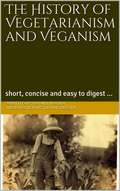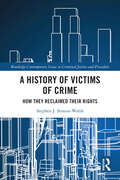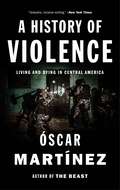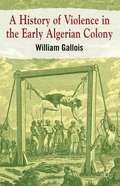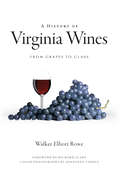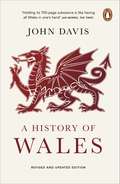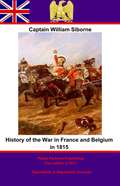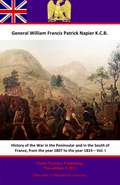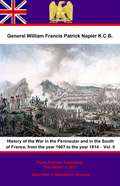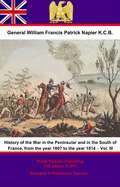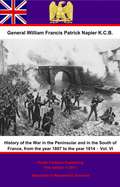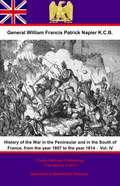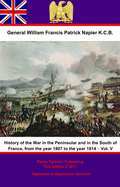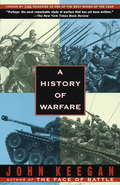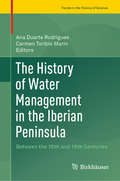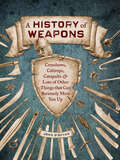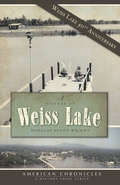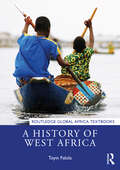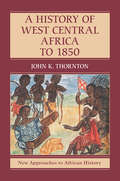- Table View
- List View
A History of Vampires in New England (Haunted America)
by Thomas D'AgostinoThe author of A Guide to Haunted New England lifts the coffin lid on the region&’s folklore and legends of the undead. New England is rich in history and mystery. Numerous sleepy little towns and farming communities distinguish the region&’s scenic tranquility. But not long ago, New Englanders lived in fear of spectral ghouls believed to rise from their graves and visit family members in the night to suck their lives away. Although the word &“vampire&” was never spoken, scores of families disinterred loved ones during the eighteenth and nineteenth centuries searching for telltale signs that one of them might be what is now referred to as the New England vampire. &“In his remarkable book . . . Thomas D&’Agostino details the longstanding belief among New Englanders that supernatural entities were responsible for the disease called consumption.&”—Crime Capsule Includes photos! Praise for A Guide to Haunted New England &“Fun, charming . . . includes not only locales with reported ghosts, but also sites with macabre (though not haunted) histories.&”—True Crime Librarian &“Anyone interested in exploring the haunted, macabre and abandoned throughout New England knows they can count on D&’Agostino to find out more about the site&’s history, past sightings and how to find them.&”—Mobile RVing
The History of Vegetarianism and Veganism: short, concise and easy to digest...
by Daniel HagenFor roughly ten generations, we have been living in an era of industrialisation. An era that keeps going non-stop. Humanity is, so to speak, in overdrive! This does also apply to our diets; meat has become a cheap mass-produced commodity and we eat sun-ripened papayas in the coldest winters. Common shrimps are caught in the Norther Sea, peeled in Morocco and then send back to Northern Germany where they are then sold and eaten as “freshly caught”. Meanwhile, there is more plastic floating around in the deep sea than maritime creatures. In a large part of the world, many humans are still suffering from malnutrition – in other parts of the globe, there has been a rapid increase in obesity, diabetes and the like. Considering this, one might think that a vegetarian and, in a wider sense, vegan approach to diets is a young phenomenon, that has sprung mainly from the wealthy, privileged classes of the First World. Though that is far from true!
A History of Victims of Crime: How they Reclaimed their Rights (Routledge Contemporary Issues in Criminal Justice and Procedure)
by Stephen J. Strauss-WalshThis book examines the evolution of the contemporary crime victim’s procedural place within modern Western societies. Taking the history of the Irish crime victim as a case study, the work charts the place of victims within criminal justice over time. This evolves from the expansive latitude that they had during the eighteenth century, to their major relegation to witness and informer in the nineteenth, and back to a more contemporary recapturing of some of their previous centrality. The book also studies what this has meant for the position of suspects and offenders as well as the population more generally. Therefore, some analysis is devoted to examining its impact on an offender’s right to fair trial and social forms. It is held that the modern crime victim has transcended its position of marginality. This happened not only in law, but as the consequence of the victim’s new role as a key sociopolitical stakeholder. This work flags the importance of victim rights conferrals, and the social transformations that engendered such trends. In this way victim re-emergence is evidenced as being not just a legal change, but a consequence of several more recent sociocultural transformations in our societies. The book will be of interest to researchers, academics, and policy makers in criminal law, human rights law, criminology, and legal history.
A History of Victoria
by Geoffrey BlaineyA History of Victoria is a lively account of the people, places and events that have shaped Victoria, from the arrival of the first Aboriginal peoples through to the present day. In his inimitable style, Geoffrey Blainey considers Victoria's transformation from rural state to urban society. He speculates on the contrasts between Melbourne and Sydney, and describes formative events in Victoria's history, including the exploits of Ned Kelly, the rise of Australian Football and the Olympics of 1956. Melbourne's latest population boom, sprawling suburbs and expanding ethnic communities are explored. Blainey also casts light on Victoria's recent political history. This edition features sections on the Black Saturday bushfires of 2009, the end of the drought and the controversy surrounding the Wonthaggi desalination plant. New illustrations, photographs and maps enrich the narrative. Written by one of Australia's leading historians, this book offers remarkable insight into Victoria's unique position within Australian history.
The History of Video Games
by Charlie FishThis book is a potted history of video games, telling all the rollercoaster stories of this fascinating young industry that’s now twice as big globally than the film and music industries combined. Each chapter explores the history of video games through a different lens, giving a uniquely well-rounded overview. Packed with pictures and stats, this book is for video gamers nostalgic for the good old days of gaming, and young gamers curious about how it all began. If you’ve ever enjoyed a video game, or you just want to see what all the fuss is about, this book is for you. There are stories about the experimental games of the 1950s and 1960s; the advent of home gaming in the 1970s; the explosion – and implosion – of arcade gaming in the 1980s; the console wars of the 1990s; the growth of online and mobile games in the 2000s; and we get right up to date with the 2010s, including such cultural phenomena as twitch.tv, the Gamergate scandal, and Fortnite. But rather than telling the whole story from beginning to end, each chapter covers the history of video games from a different angle: platforms and technology, people and personalities, companies and capitalism, gender and representation, culture, community, and finally the games themselves.
A History of Violence
by Oscar Martinez Daniela Maria Ugaz John WashingtonHeartbreaking immersion into the lives of people enduring extreme violence in Central America El Salvador and Honduras have had the highest homicide rates in the world over the past ten years. Óscar Martínez, author of The Beast, which was named one of the best books of the year by the Economist and the Financial Times, shares a beautiful and immersive account of life in one of the most violent places on earth. Martinez travels to Nicaraguan fishing towns, southern Mexican brothels where Central American women are trafficked, isolated Guatemalan jungle villages and crime-ridden Salvadoran slums. With his precise and empathetic reporting, he reveals the underbelly of some of the most dangerous places in the world, going undercover to drink with narcos, accompanying police patrols, riding in trafficking boats and hiding out with a gang informer. The result is an unforgettable portrait of a region of fear, helping to explain why migrants have been fleeing the area by the millions.From the Hardcover edition.
A History of Violence in the Early Algerian Colony
by William GalloisUsing newly-discovered documentation from the French military archives, A History of Violence in the Early Algerian Colony offers a comprehensive study of the forms of violence adopted by the French Army in Africa. Its coverage ranges from detailed case studies of massacres to the question of whether a genocide took place in Algeria.
A History of Virginia Literature
by Kevin J. HayesA History of Virginia Literature chronicles a story that has been more than four hundred years in the making. It looks at the development of literary culture in Virginia from the founding of Jamestown in 1607 to the twenty-first century. Divided into four main parts, this History examines the literature of colonial Virginia, Jeffersonian Virginia, Civil War Virginia, and modern Virginia. Individual chapters survey such literary genres as diaries, histories, letters, novels, poetry, political writings, promotion literature, science fiction, and slave narratives. Leading scholars also devote special attention to several major authors, including William Byrd of Westover, Thomas Jefferson, Ellen Glasgow, Edgar Allan Poe, and William Styron. This book is of pivotal importance to the development of American literature and of American studies more generally.
A History of Virginia Wines: From Grapes to Glass (American Palate)
by Richard Leahy Jonathan Timmes Walker Elliott RoweGo beyond the bottle and step inside the minds, and vines, of Virginia's burgeoning wine industry in this groundbreaking volume. Join grape grower and industry insider Walker Elliott Rowe as he guides you through some of the top vineyards and wineries in the Old Dominion. Rowe explores the minds of pioneering winemakers and vineyard owners, stitches together an account of the wine industry's foundation in Virginia, from Jamestown to Jefferson to Barboursville, and uncovers the fascinating missing chapter in Virginia wine history. As the Philip Carter Winery's motto explains, "Before there was Jefferson, there was Carter."? Rowe goes behind the scenes to interview migrant workers who toil daily in the vineyards, makes the rounds in Richmond with an industry lobbyist and talks shop with winemakers on the science and techniques that have helped put the Virginia wine industry on the map. Also included are twenty-four stunning color photographs from professional photographer Jonathan Timmes and a foreword by noted wine journalist Richard Leahy.
History of Virtual Work Laws
by Danilo CapecchiThe book presents a history of classical mechanics by focusing on issues of equilibrium. The historical point of view adopted here restricts attention to cases where the effectiveness of forces is assessed on the basis of the virtual motion of their points of application. For completeness, hints of the alternative approach are also referred, the Archimedean for ancient mechanics and the Newtonian for modern mechanics. The laws resulting from consideration of virtual motions are named laws of virtual work. The modern formulations of the principle of virtual work are only a particular form of them. The book begins with the first documented formulations of laws of virtual work in the IV century BC in Greece and proceeds to the end of the XIX century AD in Europe. A significant space is devoted to Arabic and Latin mechanics of Middle Ages. With the Renaissance it began to appear slightly different wordings of the laws, which were often proposed as unique principles of statics. The process reached its apex with Bernoulli and Lagrange in the XVIII century. The book ends with some chapters dealing with the discussions that took place in the French school on the role of the Lagrangian version of the law of virtual work and its applications to continuum mechanics.
A History of Wales
by John DaviesStretching from the Ice Ages to the present day, this masterful account traces the political, social and cultural history of the land that has come to be called Wales. Spanning prehistoric hill forts and Roman ruins to the Reformation, the Industrial Revolution and the series of strikes by Welsh miners in the late twentieth century, this is the definitive history of an enduring people: a unique and compelling exploration of the origins of the Welsh nation, its development and its role in the modern world. This new edition brings this remarkable history into the new era of the Welsh Assembly.
A History of War Crimes Trials in Post 1945 Asia-Pacific
by Zhaoqi ChengWritten by the Director of the Tokyo Trial Research Centre at China's Shanghai Jiao Tong University, this book provides a unique analysis of war crime trials in Asia-Pacific after World War II. It offers a comprehensive review of key events during this period, covering preparations for the Trial, examining the role of the War Crimes Commission of the United Nations as well as offering a new analysis of the trial itself. Addressing the question of conventional war crimes, crimes against humanity, crimes against peace (such as the Pearl Harbor Incident) and violations of warfare law, it follows up with a discussion of post-trial events and the fate of war criminals on trial. Additionally, it examines other Japanese war crime trials which happened in Asia, as well as considering the legacy of the Tokyo trial itself, and the foundation of a new Post-War International Order in East Asia.
History Of The War In France And Belgium In 1815. 3rd Edition
by Pickle Partners Publishing Captain William SiborneThis ebook is purpose built and is proof-read and re-type set from the original to provide an outstanding experience of reflowing text for an ebook reader. When Captain Siborne died in 1849, it is unlikely that he was aware of the enduring historical legacy that he was to leave behind. His History of the War in France and Belgium in 1815 has become the most well known English history of the famous campaign and despite being written over 150 years ago is still in print, still eminently readable and remarkably accurate. The book was the result of his life's work and passionate dedication to the "Waterloo Model" which depicts a stage of the battle in tremendous detail. The accuracy of the book is accounted for by four tremendously important points; Firstly, Siborne was engaged by the British military establishment to produce a model of the battle of Waterloo, which he did with scrupulous accuracy including painstaking research on the battle ground and environs including surveys of the ground. Secondly, Siborne was a noted topographical engineer who wrote a number of treatises and one of the standard works of the time enabling his appreciation of the battle to be precise and avoid fault of many histories written merely from maps (some produced years afterward)of the area. Thirdly, he undertook what was a the time a ground-breaking "questionnaire" of the surviving officers of the British, King's German Legion, Hanoverian units involved, to piece together the events of the day. These letters were published in part by Siborne's son much later. Fourthly he expanded his search for eye-witness testimony to both the Prussian and French army staffs, and although rebuffed by the French, who were understandably tender about the loss of the battle and their Emperor with it, his enquiries were fruitful amongst the Prussian command who supplied a priceless counterbalance to the sometimes jingoistic British accounts. Siborne and his works were ahead of their time, and his search for an accurate representation of the battle won him few friends at Horse Guards. Funding was difficult to obtain from the British establishment and Siborne's attempts at self-funding the model which was his life's work were unsuccessful, Siborne died a broken man. He left behind the "Waterloo Model" and a larger scale model which are housed at the Royal Army Museum in London and this excellent book. We chose the third edition as it includes the impassioned defence of his work against the plagiarism of Rev R Gleig's "Story of Waterloo" and a number of notable changes from the first and second editions prompted by further eye-witness testimony gathered by Siborne. Text taken, whole and complete, from the 1848 third edition, published in London by T and W Boone Original - 667 pages. Author - Captain William Siborne (15 October 1797-9 January 1849) Linked TOC. - in keeping with the format of the times that the book was published the table of contents includes the summary notes of each chapter.
History Of The War In The Peninsular And In The South Of France, From The Year 1807 To The Year 1814 – Vol. I (History Of The War In The Peninsular And In The South Of France, From The Year 1807 To The Year 1814 #1)
by General William Francis Patrick Napier K.C.B.William Napier, was born in Dublin in 1785, one of a number of brothers who entered the British army and excelled in the service although it is his History of the War in the Peninsular that he is most remembered for. A masteful, epic account of the Spanish Ulcer that drained Napoleon's resources and played a pivotal role in the end of his domination of Europe.<P><P> Napier gained his first commission as an ensign in the Royal Irish Artillery in 1800. By the time of the Napoleonic Wars he had transferred to to the 52nd Regiment, which was being trained as light infantry at Shorncliffe under Sir John Moore. Napier saw his first service in the Peninsular with the 43rd Foot under Sir John Moore during the Corunna campaign. Napier would go on to be conspicuous in the actions of the Light Division, such as the epic march to Talavera, the battles of Fuentes d’Oñoro, Salamanca, Nivelle, Orthes and Toulouse. He left the service a General and Knight Commander of the Order of Bath.<P> In this first volume (1807 to beginning of 1809), Napier surveys the scene in mainland Europe and particularly Spain and Portugal, the rotten state of politics in Spain, the isolation of Portugal as the only ally of Great Britain still not under Napoleon’s domination. He starts with the machinations of the French to supplant the Bourbon regime in Spain and the joint Franco-Spanish invasion of Portugal with its flood of French troops supposed friends soon to be enemies. The initial disastrous campaigns of the splintered Spanish armies are written of in great detail, battles such as Rio Seco and Ucles, and the parlous state of the Spanish government are shown in all their infamy, juxtaposed to the second defence of Sarragossa by the valorous Spaniards. Wellington’s first short-lived campaign in Portugal, including the battle of Vimiero is given due attention and much is lavished on the campaign of Sir John Moore.<P> A Classic, deserves to be read and re-read.
History Of The War In The Peninsular And In The South Of France, From The Year 1807 To The Year 1814 – Vol. II (History Of The War In The Peninsular And In The South Of France, From The Year 1807 To The Year 1814 #2)
by General William Francis Patrick Napier K.C.B.A masterful, epic account of the Spanish Ulcer that drained Napoleon's resources and played a pivotal role in the end of his domination of Europe.The author served with distinction in the actions of the Light Division, such as the epic march to Talavera, the battles of Fuentes d'Oñoro, Salamanca, Nivelle, Orthes and Toulouse. He left the service a General and Knight Commander of the Order of Bath. Napier's History would rank as the most important history to be written by an actual participant, and was as controversial with his countrymen as amoung his contemporaries on the Continent. ]Continuing on from his first volume, Napier's second volume focuses on the period (late 1808-mid 1810). Starting in earnest with the second French invasion of Portugal, and the re-introduction of the Duke of Wellington to the Peninsular, having being called back to England to face a Court of Inquiry over the convention of Cintra [by whom he was exonerated fully, even praised]. The state of Portugal's defence is assessed, brave soldiers but not organised into an army as yet, and the far-reaching appointment of the English general William Carr Beresford as Portuguese Marshal detailed along with the militia raised in the provinces. Thus with inauspicious beginnings Wellington, begins his first full campaign in the Peninsula. The lightning capture of Porto and the pursuit of Soult's Army of Portugal then ensue before Wellington makes his first foray into Spain. Culminating in the battle of Talavera, although on paper won bloodily, and a somewhat dangerous retreat follow, the fruits of bad co-operation of the parts of the Allies bordering on malign behaviour.Napier goes to some trouble to cover all areas of the Peninsular, not just those that the British soldiers were directly involved in.
History Of The War In The Peninsular And In The South Of France, From The Year 1807 To The Year 1814 – Vol. III (History Of The War In The Peninsular And In The South Of France, From The Year 1807 To The Year 1814 #3)
by General William Francis Patrick Napier K.C.B.A masterful, epic account of the Spanish Ulcer that drained Napoleon's resources and played a pivotal role in the end of his domination of Europe.The author served with distinction in the actions of the Light Division, such as the epic march to Talavera, the battles of Fuentes d’Oñoro, Salamanca, Nivelle, Orthes and Toulouse. He left the service a General and Knight Commander of the Order of Bath. Napier’s History would rank as the most important history to be written by an actual participant, and was as controversial with his countrymen as amoung his contemporaries on the Continent. In this third volume (Mid-1810 to Sept 1811), covers the third French invasion of Portugal under Massena, although he outnumbers his British and Portuguese opponents is beset by problems, not the least of which are his sub-ordinates who are loath to obey him. As he drives into Portugal he is given a bloody nose at the battle of Busaco, and a horrible surprise at the lines of Torres Vedras, which are impregnable. Forced to retire through devastated countryside, culminating in the battle of Fuentes D’Oñoro as he tries to relieve the garrison of Almeida, which had been left behind. All in all the French would never set foot in force again in Portugal and Wellington’s strategies would be vindicated.However Napier put these events in their proper context, the seemingly inexorable march to an Allied victory is far from the reality of the situation; an expedition to Fuengirola under Lord Blayney is routed, British expeditions along the Eastern coast of Spain are foiled and in the case of Taragona, it falls in sight of the force sent to aid it. The Regency of Portugal and the court in Brazil intrigue and cause trouble and strife, the Spanish troops start to rack up some small scale victories but are handled and led badly in most cases. The detached corps of Marshal Beresford fights the bloody battle Albuera, Napier is none too kind in his criticisms of his actions.
History Of The War In The Peninsular And In The South Of France, From The Year 1807 To The Year 1814 – Vol. III (History Of The War In The Peninsular And In The South Of France, From The Year 1807 To The Year 1814 #6)
by General William Francis Patrick Napier K.C.B.A masterful, epic account of the Spanish Ulcer that drained Napoleon's resources and played a pivotal role in the end of his domination of Europe.<P><P> The author served with distinction in the actions of the Light Division, such as the epic march to Talavera, the battles of Fuentes d’Oñoro, Salamanca, Nivelle, Orthes and Toulouse. He left the service a General and Knight Commander of the Order of Bath. Napier’s History would rank as the most important history to be written by an actual participant, and was as controversial with his countrymen as amoung his contemporaries on the Continent. In this third volume (Mid-1810 to Sept 1811), covers the third French invasion of Portugal under Massena, although he outnumbers his British and Portuguese opponents is beset by problems, not the least of which are his sub-ordinates who are loath to obey him. As he drives into Portugal he is given a bloody nose at the battle of Busaco, and a horrible surprise at the lines of Torres Vedras, which are impregnable. Forced to retire through devastated countryside, culminating in the battle of Fuentes D’Oñoro as he tries to relieve the garrison of Almeida, which had been left behind. All in all the French would never set foot in force again in Portugal and Wellington’s strategies would be vindicated.<P> However Napier put these events in their proper context, the seemingly inexorable march to an Allied victory is far from the reality of the situation; an expedition to Fuengirola under Lord Blayney is routed, British expeditions along the Eastern coast of Spain are foiled and in the case of Taragona, it falls in sight of the force sent to aid it. The Regency of Portugal and the court in Brazil intrigue and cause trouble and strife, the Spanish troops start to rack up some small scale victories but are handled and led badly in most cases. The detached corps of Marshal Beresford fights the bloody battle Albuera, Napier is none too kind in his criticisms of his actions.
History Of The War In The Peninsular And In The South Of France, From The Year 1807 To The Year 1814 – Vol. IV (History Of The War In The Peninsular And In The South Of France, From The Year 1807 To The Year 1814 #4)
by General William Francis Patrick Napier K.C.B.A masterful, epic account of the Spanish Ulcer that drained Napoleon's resources and played a pivotal role in the end of his domination of Europe.<P><P> The author served with distinction in the actions of the Light Division, such as the epic march to Talavera, the battles of Fuentes d’Oñoro, Salamanca, Nivelle, Orthes and Toulouse. He left the service a General and Knight Commander of the Order of Bath. Napier’s History would rank as the most important history to be written by an actual participant, and was as controversial with his countrymen as amoung his contemporaries on the Continent.<P> In this fourth volume (end-1811 to December 1812), covers the major Anglo-Portuguese offensive of 1812, whilst Napoleon embarks on his disastrous campaign to Russia, Wellington struck into mainland Spain. Although hampered by numerous supply issues, not least caused by the Spanish government or lack thereof, Wellington drove through the southern corridor between Portugal and Spain, taking the key fortresses of Cuidad Rodrigo and Badajoz. The last siege was a particularly bloody affair and cost Wellington a great many soldiers ending in an infamous orgy of lotting. Wellington manoeuvred to keep his prizes whilst Marmont with a similarly sized French army sought to cut him off from Portugal. These movement culminated in the battle of Salamanca, which was described at the time by a French officer, as the 'beating of forty thousand men in forty minutes.'. It was a masterpiece of timing and skill, and is widely regarded as Wellington’s masterpiece.<P> Despite all of the favourable items in the Allies favour, the concentration of the French armies led to the abandonment of Madrid after a brief period of occupation by Wellington’s troops, and the futile attempt to lay siege to Burgos. The Spanish and Anglo-Sicilian attempts in the eastern provinces ended in failure and in some cases ignominy. Much further fighting lay ahead before the French would be ejected from the Peninsular.
History Of The War In The Peninsular And In The South Of France, From The Year 1807 To The Year 1814 – Vol. V (History Of The War In The Peninsular And In The South Of France, From The Year 1807 To The Year 1814 #5)
by General William Francis Patrick Napier K.C.B.A masterful, epic account of the Spanish Ulcer that drained Napoleon's resources and played a pivotal role in the end of his domination of Europe.<P><P> The author served with distinction in the actions of the Light Division, such as the epic march to Talavera, the battles of Fuentes d’Oñoro, Salamanca, Nivelle, Orthes and Toulouse. He left the service a General and Knight Commander of the Order of Bath. Napier’s History would rank as the most important history to be written by an actual participant, and was as controversial with his countrymen as amoung his contemporaries on the Continent.<P> In this fifth volume (early 1813 to December 1813), Napier follows the Allied forces in their march to the French frontier and beyond. As Napoleon attempts to recover from the shattering failure of the 1812 Russian campaign and regain the initiative in Germany, the Duke of Wellington’s army, British, Portuguese and Spanish, begins to assert a dominance over their French opponents in the Peninsular. Despite further political manoeuvring the Spanish and with the Regency in Portugal, Wellington sent his army of a brilliant series of outflanking moves, culminating in the crushing of the French armies at Vitoria. Although he was enabled by this victory to push to the French frontier, he was left with two sieges at Pamplona and St Sebastian behind his lines,and a re-organized French army under Soult to his front. Eventually defeating the French offensive designed to relieve Pamplona, despite some less than spectacular performances by some of his subordinates, Wellington was able to invade France proper. A number of battles such as St. Pierre, and the Nivelle, all allied successes, resulted in a proper push toward final victory.<P> Napier also covers the events in other parts of Spain, where the very capable Marshal Suchet was able to fight off a number campaigns in Catalonia or aiming for Catalonia, despite the British command of the seas.
A History of Warfare
by John KeeganThe acclaimed author of The Face of Battle examines centures of conflict in a variety of diverse societies and cultures. "Keegan is at once the most readable and the most original of living military historians . . . A History of Warfare is perhaps the most remarkable study of warfare that has yet been written."--The New York Times Book Review.
The History of Water Management in the Iberian Peninsula: Between the 16th and 19th Centuries (Trends in the History of Science)
by Ana Duarte Rodrigues Carmen Toribio MarínThis volume approaches the history of water in the Iberian Peninsula in a novel way, by linking it to the ongoing international debate on water crisis and solutions to overcome the lack of water in the Mediterranean.What water devices were found? What were the models for these devices? How were they distributed in the villas and monastic enclosures? What impact did hydraulic theoretical knowledge have on these water systems, and how could these systems impact on hydraulic technology? Guided by these questions, this book covers the history of water in the most significant cities, the role of water in landscape transformation, the irrigation systems and water devices in gardens and villas, and, lastly, the theoretical and educational background on water management and hydraulics in the Iberian Peninsula between the sixteenth and the nineteenth centuries.Historiography on water management in the territory that is today Spain has highlighted the region’s role as a mediator between the Islamic masters of water and the Christian world. The history of water in Portugal is less known, and it has been taken for granted that is similar to its neighbour. This book compares two countries that have the same historical roots and, therefore, many similar stories, but at the same time, offers insights into particular aspects of each country. It is recommended for scholars and researchers interested in any field of history of the early modern period and of the nineteenth century, as well as general readers interested in studies on the Iberian Peninsula, since it was the role model for many settlements in South America, Asia and Africa.
A History of Weapons: Crossbows, Caltrops, Catapults & Lots of Other Things that Can Seriously Mess You Up
by John O'BryanOne day a prehistoric guy picked up a rock and threw it at something. And the history of weapons began. Comedy writer and weapon nerd John O'Bryan relays the freaky highlights of man's centuries-old obsession with weaponry. He hilariously explains the mace, the morning star, and the man catcher, while conveying factual information about each weapon: its history, uses, and badass potential. Looking through history's highlights, readers will learn about Attila the Hun, Genghis Khan, and the "peaceful" Shaolin monks. This ultimate compendium of awesome weapons delivers all the surprisingly true details sure to impress anybody who's ever made a gun with their fingers and said, "PEW-PEW-PEW!"
A History of Weiss Lake
by Douglas Scott WrightUntil the late 1950s, the major body of water for residents of northeast Alabama was the Coosa River, which wove prominently through the rural landscape of the region. When Alabama Power Company decided to dam the river in order to build a thirty-thousand-acre reservoir, locals were divided about whether to welcome the hydroelectricity and potential prosperity or resist losing their land and proud agrarian heritage. Three years and millions of cubic yards of earth later, Weiss Lake emerged to alter Cherokee County history permanently. Post editor and county native Scott Wright presents a captivating collection of personal recollections and historical vignettes to illustrate the magnitude of the lake's influence in shaping the future of the area--and damming its past.
A History of West Africa (Routledge Global Africa Textbooks)
by Toyin FalolaThis book introduces readers to the rich and fascinating history of West Africa, stretching all the way back to the stone age, and right up to the modern day. Over the course of twenty seven short and engaging chapters, the book delves into the social, cultural, economic and political history of West Africa, through prehistory, revolutions, ancient empires, thriving trade networks, religious traditions, and then the devastating impact of the Trans-Atlantic slave trade and subsequent colonial rule. The book reflects on the struggle for independence and investigates how politics and economics developed in the post-colonial period. By the end of the book, readers will have a detailed understanding of the fascinating and diverse range of cultures to be found in West Africa, and of how the region relates to the rest of the world. Drawing on decades of teaching and research experience, this book will serve as an excellent textbook for entry-level History and African Studies courses, as well as providing a perfect general introduction to anyone interested in finding out about West Africa.
A History of West Central Africa to 1850 (New Approaches to African History #14)
by John K. ThorntonBased on substantial new research from primary sources and archives, this accessible interpretative history of West Central Africa from earliest times to 1852 gives comprehensive and in-depth coverage of the region. With equal focus given to both internal histories or inter-state interactions and external dynamics and relationships, this study represents an original approach to regional histories which goes beyond the existing scholarship on the area. By contextualising and expanding its range, to include treatment of the Portuguese colony of Angola, John K. Thornton provides new understandings of significant events, people, and inter-regional interactions which aid the grounding of the history of West Central Africa within a broader context. A valuable resource to students and scholars of African history.

